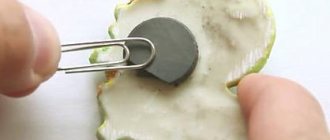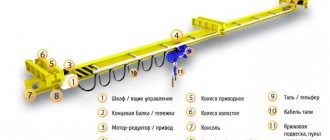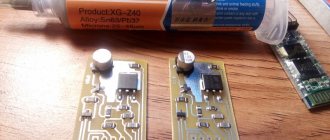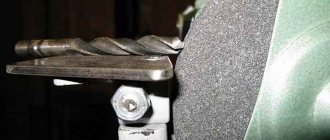Description
What is a kruporushka
The device is used for quick preparation of feed from crushed grain. Otherwise they are called grain crushers. On an industrial scale, grain crushers are used in poultry farms and food processing plants.
The following products are most often processed using this method:
- wheat;
- peas;
- millet;
- barley;
- oats;
- buckwheat;
- rice;
- corn;
- peas;
- soybeans
The main difference between a grain grinder and a mill: the grains are not ground into flour, but are simply crushed into several relatively large parts.
Where and how to use
Using the grinder is very simple. At the top there is a bunker where raw materials are loaded. Grinding is carried out in a drum, which is driven by an electric motor. In the drum, the grain is also mixed with other additives - grass, dried vegetables, straw.
Most often, on private farms, grains are used to prepare feed for birds, pigs and cattle. Many types of cereals are processed in agricultural production in a similar way.
Principle of operation
The grains are sent to the receiving hopper, after which they arrive in portions, having gone through the calibration stage. After the preliminary stage of dehusking, the grain enters a drum, in which it is divided into four unequal parts. The different sizes of particles determine the cyclical nature of the work: first, larger pieces are crushed, then small ones go to even smaller ones, until the finished product acquires the same size and beautiful appearance.
The incoming product can be automatically sorted by simply placing a sieve at the outlet. As a result, smaller fractions will be used as poultry feed, while larger fractions will be used for cattle. The productivity of the grinder depends on the hardness and other characteristics of the raw material and ranges from 150 to 300 kilograms per hour. You can additionally equip the device with a grinding device, and then you can eat high-quality grain yourself.
How to choose a grain crusher: expert advice
Choosing the right model
How should you choose a crusher that will meet all consumer requirements? To do this, you need to know the answers to some questions:
- Performance. A high grinding speed ensures high productivity in obtaining finished products, and accordingly, the use of such an installation will be highly efficient. Such installations can be considered the optimal solution for large farms. For home work, an installation with a low or medium processing speed of raw materials is sufficient.
- Price. The equipment must not only ensure high quality of the resulting product, but also generate certain income to recoup the investments made in this equipment.
- Grinding degree. The device must be selected based on the type of livestock and poultry the produced feed will be intended for.
- Drive station power. The greater the power of the installed power plant, the greater the productivity of the installation. It must be taken into account that the higher the engine power, the higher the energy costs.
- The company is a manufacturer. Undoubtedly, there are world-famous companies that produce shredders, but you need to think three times about how quickly the funds invested in brands will pay off.
When choosing a model, you must be guided by the characteristics specified by the manufacturer.
Types of crushers
Crushers can be divided into several classes:
- Industrial - they are used in large agro-industrial farms.
- Household - they have found their application in household plots.
Household grain crusher
Industrial grain crusher
Another classification option can be given.
The numerous range of crushers can be classified as follows - according to the type of feed processed:
- Plants for root processing. It is used for cutting root vegetables and further mixing with food additives and vitamins.
- Silage processing plants - this equipment is used for crushing grain sprouts, grass or malt.
Silage processing plant
In addition to the listed installations, the industry also produces universal equipment. It can be used to process all types of feed.
Raw materials and finished product
Grain crushers, often called grain grinders, grinders, etc., are used to produce feed mass in a home or farm environment.
Grain and root crops are used as raw materials to obtain finished feed. You need to understand that the same devices can be used to process grain and root crops, but sometimes it is necessary to re-adjust the grain crusher.
When making a grain crusher with your own hands, you must remember that after processing on the grinder you can produce feed pellets of different sizes, some of which will be suitable for cattle, others for poultry. The installation parameters and dimensions of crushing devices (knives, hammers, drums) must be selected accordingly.
After receiving the crushed product, food additives, vitamins and other components necessary to obtain a complete feed are mixed into it.
Pipe peeler
A do-it-yourself corn sheller can be made from a piece of pipe and a drill. This apparatus consists of:
- Housings,
- Apparatus for chopping cobs,
- Basics,
- Drills,
- Watering cans,
- Khomutov.
The working container of the chopper is made from a piece of pipe. The diameter of the pipe depends on the volume of raw materials intended for processing. An even number of teeth are made in the front part of the pipe cut, and every second tooth is pressed against the axis. Using a grinder, several rectangular holes are cut through which the finished husked grain will be poured into the watering can. On the opposite side, a cutting disc with a tail is attached to the shaft.
The body of the corn cob chopper is made of durable steel. The body is conventionally divided into two parts: in the front, a rectangular hole is made for loading cobs, and in the back, a similar one is made for the exit of heads of cabbage, cleared of grains. The body is bolted to a base welded from steel angles.
The tail of the shaft, to which the cutting disk is attached, is clamped in the drill chuck. The drill itself is attached to the base using clamps. The device turns out to be less powerful than from a washing machine, but it is quite capable of shelling grain for a small private farm and for obtaining seed material.
Kruporushka from angle grinder
Making a grain crusher is very simple - even a beginner can handle the task. In this case, a homemade grain crusher will not require expensive components during assembly.
Tools and materials
It is necessary to prepare everything you need in advance so as not to be distracted while working with electrical equipment.
To make a grain crusher you will need the following materials:
- angle grinder (angle grinder);
- sheet of metal - preferably stainless or alloy steel;
- fasteners;
- drill;
- roulette.
As you can see, nothing expensive is required.
Preparation of material
Stages:
- First you need to cut out the two side covers of the case.
- Drill a hole in one of the covers equal to the diameter of the grinder shaft.
- Drill holes for the mounting washers, then four holes for the coupling bolts.
- Cut a strip of metal. One part will be used to make a sieve, in which cells of the same diameter are shot through according to a certain pattern, chosen independently.
- Then the sieve should be bent in a semicircle.
- The second strip is used to make end caps.
- From the remains of the leaf you can make a knife for grinding cereals.
- An incision is made along the edges of the second strip, and a hole is drilled in the middle.
Welding
First you need to weld the end caps, then the sieve. A strip is attached to the top of the machine at an angle of 15-20 degrees, which will prevent the grain from flying back out of the machine.
It is very important to select the thickness of the metal in advance - at least four millimeters, so that the housing and the grain guard are strong enough. Grains are hard abrasive particles that can ruin even expensive and massive industrial equipment within a few years.
Assembly
Step-by-step instruction:
- It is necessary to screw the washer and install the angle grinder.
- A knife should be installed on its shaft and securely secured with a nut.
- Then install the side cover. It can be attached with wing nuts for quick and easy removal and reattachment.
- A funnel for feeding raw materials can be made from a plastic bottle.
- The final touch is to attach a bag or sleeve to the bottom of the apparatus for collecting the finished feed.
Kruporushka from an angle grinder
There is another version of the product made from an angle grinder. This corn and grain crusher may not even have a frame. The device's performance is low. However, the ease of manufacture more than compensates for all the shortcomings.
Necessary equipment
The grains will be quite large, so this feed will be more suitable for cattle than for poultry. Chickens will not be able to peck such particles at all, at least after the first run of grains through the apparatus.
To make a grain crusher you will need the following materials:
- Bulgarian;
- old circle for cutting wood;
- a small sheet of thick plywood;
- plastic water containers with a volume of five to six liters;
- old saucepan.
It is advisable to use an inexpensive grinder so that you don’t feel sorry for ruining it due to the high abrasiveness of grain particles.
Step-by-step instruction
It is advisable to adhere to a certain sequence of work.
Main stages:
- Make a knife for crushing cereals from an old wood wheel.
- Use plywood as a frame for the grinder. It is advisable to cut holes out of plywood for the handle of the grinder.
- Drill holes of the same diameter in the bottom of the pan where the finished product will flow. The bottom can be removed by replacing it with a sieve.
- The water container (bottle or bottle) will serve as a funnel to feed raw materials into the drum. To do this, you need to remove the bottom of the tank, leaving only the cone-shaped section: the neck and the expanding part.
- Assemble all the elements: attach the electric motor casing to the hopper and base, and attach it to the top of the tank using fasteners.
- Place the knife in the body of the working chamber, which must be attached to the plywood base. A protective mesh should be placed on top of the knives, which additionally serves as a sieve.
The manufacture of such a device is accessible to everyone, because it does not require special skills, expensive parts and materials.
Grain crusher from a vacuum cleaner
A homemade crusher can also be assembled from a vacuum cleaner.
To perform this task with your own hands, the vacuum cleaner itself is not particularly needed. Just the engine is enough. The sequence of making a shredder with your own hands is as follows.
To form the base, you can use laminate or plywood.
DIY grain crusher from a vacuum cleaner
In its center it is necessary to form a hole for installing the engine.
To make working knives with your own hands, it is permissible to use a steel plate. A width of up to 20 cm and a thickness of 1.5 - 2 mm can be considered optimal.
The knife must be fixed on the motor shaft.
You can use a kitchen sieve as a working chamber.
It is necessary to install a bunker under the sieve, where the finished product will be sent. A plastic bottle can play the role of a bunker.
Other models
Crusher from washing machine
The principle of operation of the grinder in this case will resemble a coffee grinder. This type is most suitable for crushing corn, because the knives rotating in the drum work best with large and relatively soft grains. The device can be made from any model of washing machine, but the manufacturing principle is the same.
The following steps must be completed:
- Install the first motor with the bushing and blades at the bottom of the washing machine tub. There will also be a mesh and an outlet window through which the finished product will flow.
- The second motor, also equipped with a bushing and blades, must be secured at the inlet hole near the base. A tin can placed over the knives will act as a barrier against dust and contaminants.
- The shafts must be installed at an angle of 25 degrees to each other, because they will rotate in different directions. This angle will ensure maximum performance of the mechanism.
- The input funnel for raw materials can be of any size. However, it is advisable to make it large, because a washing machine crusher is very powerful and designed for high productivity. You can regulate the supply of cereals by installing a shutter at the bottom of the funnel.
- The container for the finished product should be installed under the grain crusher. It is better to equip the device with a sleeve to prevent fine dust from getting into the air.
As you can see, the main element of such a grinder is the drum of the washing machine, and the main additions - a funnel and a container - are very easy to manufacture.
Homemade mill
A homemade crusher mill at home can be made from a rotor and stator, which will serve as millstones.
Manufacturing instructions:
- Install a single-phase electric motor with a power of 1 kW and a voltage of 220 Volts on the box.
- The crusher body must have a diameter of 35 centimeters and be made of steel strip. The stator is installed at the bottom, the rotor is installed on the motor shaft. The shaft moves at an angular speed of 3000 revolutions per minute.
- The hopper should be attached to the top of the housing using bolts. It should have a cone shape to make it convenient to pour the raw materials. It is advisable to equip the funnel with a shutter. The lower part of the apparatus must be equipped with a window for exiting the finished product. If possible, you need to equip the outlet with a sleeve.
- You can make a stator like this: take a steel plate 5 cm wide, give it the shape of a cylinder and place it in a container for subsequent pouring. The bottom of the cylinder should be 4 mm thick, and the walls should be covered with a layer of aluminum. To increase the rigidity of the stator, you need to weld 2x2x5 angles inside the bowl.
- Drill a hole in the center for the shaft. Make a rotor blank - cut a circle from sheet steel with a diameter of 32 cm, measure 2 cm from the edge and draw a circle.
- Divide the circle into 32 equal parts, drill holes in each, and cut strips from them with a hacksaw to the edge of the disk. Bend the resulting petals. Weld a bushing in the center of the rotor with a diameter of 3 and a height of 5 centimeters, respectively.
For proper operation, you must first install the stator on the shaft, and only then install the rotor on the gasket.
From an old vacuum cleaner
In this case, a motor from an old, but still working properly vacuum cleaner will come in handy.
Step-by-step instructions for making such a grain crusher:
- The base of the device must be made from a square sheet of plywood with an edge length of 30 cm. The motor from the vacuum cleaner must be attached to the plywood so that it protrudes 4 cm down.
- The knife should be made of a steel plate with dimensions HxLxW equal to 1.5x20x1.5 cm. The leading edges of the knife are sharpened towards the axis of rotation. You need to drill a hole in the middle of the knife to fit it onto the shaft.
- The working chamber must be made of a plate 6 cm wide and 70+1 cm long (taking into account the allowance). The leaf must be wrapped in a ring. Attach three wooden rods at equal distances to secure the grain crusher at the bottom of the chamber.
The holes for the crusher mesh vary depending on the purpose of the crusher. The diameter of the cells for flour should be very small, for mixed feed - several times larger. The funnel for feeding raw materials must be equipped with a shutter; to receive the finished product, a sleeve or a regular container should be installed if the feed size is large.
How to make a grain crusher "Khadyzhenskaya"
The Khadyzhenskaya grain crusher is suitable for self-assembly. Its design minimizes the disadvantages of other types of units. To work you will need:
- emery wheel;
- radial ball bearings;
- bastard file;
- single-phase electric motor 1-1.5 kW;
- cord belt;
- steel corner 40x40mm;
- bolts from M4 to M10;
- nuts;
- spring washers;
- steel sheet 3 mm thick;
- steel shaft made of steel 40;
- clamping nut and steel bearing housings.
Follow the step by step instructions:
Step 1. The spars, which form the base, need to be attached to the sides of the frame on the front and rear using tie pins.
Step 2. Then they are fastened by welding.
Step 3 . A previously designed shaft with a circle is inserted into the recesses of the walls with a slope according to the drawings. The grooves are sealed.
Step 4. The bearings are clamped on the sides with clamping nuts, and the side members are pressed on the top, installing them on M8 stand-up bolts, according to the drawings.
Step 5 . Displacement along the crusher axis is eliminated by attaching another stand to the surface of the rear spar.
Step 6 . The brute file is installed from the inside of the grain crusher so that the required gap is established between its grooved surface and the emery wheel. To obtain this gap, install an adjusting unit according to the diagram.
Step 7. For simple fastening of various rollers, use a flange, which is attached to the shaft with an emery wheel using a key in the form of a prism. Pulleys can also be used from car engines.
In order for the grinder to work from the mains at home, you need a single-phase electric motor. But if this is not the case, then you can replace it with a three-phase one.
Watch the video: Grain crusher from a washing machine centrifuge engine
An electric motor from old agricultural machinery will also work, you just need to check it for serviceability. To assemble the engine, you will also need a magnetic starter, current relays, a switch with a visible circuit break - all devices that can make the operation of the grinder as safe as possible.
To make grain crushers, you will need the following diagrams and drawings:
Simple maintenance and long service life make the Khadyzhenskaya model grain grinder an excellent assistant in the household. Knowing how to make a grain crusher at home using photos and drawings , you can prepare nutritious feed for birds and livestock for the winter.
Grain crusher: drawings, diagrams, dimensions, photos and videos of a homemade grain crusher. A grain crusher is an indispensable thing in the household; it is used for grinding grains of cereal crops - corn, wheat, barley, oats, for preparing dirt or feed for poultry and animals.
Households usually do not require a powerful mill; a small grain crusher is quite sufficient, which we will manufacture in this article.
There are quite a few types of grain crushers; we will look at the simplest version of a homemade grain crusher that you can make with your own hands.
To make a crusher you will need:
- Electric motor with a power of about 1 kW.
- Sheet metal 3 mm thick.
- Hardened steel for a knife.
- Bolts, nuts, washers, screws - M8.
- A metal barrel or container of suitable size.
- Grinder with cutting wheel.
- Electric drill.
- Grinding machine.
- Welding machine.
- Locksmith's tool.
Tools for making a grain crusher
You can even make a grain crusher from an angle grinder, which is more often called a grinder. This will save quite a lot of money. A reliable design can be produced quite quickly. It will process a lot of grain, which will be enough to feed even a large herd of cattle.
First of all, you need to stock up on the following tools to make a homemade grain crusher with your own hands:
- Electric drill and attachments for working with wood and metal.
- Pliers, screwdrivers.
- Vise.
- Set of wrenches.
Structure of a grain crusher, design features of the machine
Manufacturers put a variety of crushers on the market, with different characteristics, productivity, etc. Most of this equipment is easy to maintain and does not take up much space. As noted above, in practice crushers are used that use rotary or hammer principles in their operation.
DIY diagram for assembling a grain crusher
Structure of a grain crusher
Rotary machines have a drum with knives. In hammer mills, hammers are used as a working tool, which are loaded inside the drum.
By the way, there is equipment that uses compressed air as an energy source. The processed raw material moves inside the drum along with air. As a result of this, the quality of the resulting product increases dramatically. In addition, in this, and in many other designs, magnets are used that select metal particles that get into the mixture.
Advice from experienced specialists
Making a knife for equipment
The grinder for corn and grain must be equipped with sharp and strong knives. For their manufacture, you can use any metal plate (preferably stainless or alloy steel). The thickness of the plate should be at least 1.5 millimeters with a productivity of no more than fifty kilograms of feed per hour.
The thickness of the knives should be increased in proportion to the load: approximately half a millimeter per 50-70 kilograms per hour of productivity. The length of the blade plate must be at least 20 centimeters. The knife must be sharpened towards the axis of rotation.
Making a sieve
The sieve layout must be thought out long before assembling the apparatus. The type of final product will depend on the diameter of the cells: from flour and small particles to large pieces of half a corn grain.
Cereals enter the working chamber of the grain mill from the funnel for feeding raw materials. It is in the working chamber that the sieves should be located - preferably several pieces, in order to carry out complete cleaning along the entire surface of the drum. In factory designs, sieves with meshes of different sizes are used to simultaneously collect products from two or even three fractions.
The sieve must be wear-resistant: abrasive grain particles can very quickly damage any device. It is best to use alloyed steel: with the addition of 0.7-0.11% tungsten or bismuth. Most likely, you will have to look for such alloys on sale for a very long time, so ordinary stainless steel will do. However, you need to take into account that it will not last more than two to three years.
Features of stator manufacturing
The stator is made of sheet steel, the thickness should be 2-2.5 millimeters. The width with a thickness of two millimeters should be equal to five centimeters. The strip needs to be bent around the circumference and placed in a mold for pouring, covering one end with aluminum to form a kind of bowl. The thickness of the bowl, taking into account the illumination, should be four millimeters.
The next stage of manufacturing the part is adding ribbing. To do this, pre-cut small corners must be welded to the side of the cylinder. They need to be placed on the inner side of the stator.
Making a knife for equipment
A do-it-yourself grain grinder must be made using a knife, which must rotate at high speed, due to which the grain will be ground; this element must be performed separately. To do this, you will need to use a steel plate, which should have dimensions of 15 × 200 millimeters, while the thickness should be 1.5 m. It is preferable to choose the strongest materials. In addition, you can use car holders or other parts that can be borrowed from household appliances. The knife should be sharpened in the form of a blade; for this, both edges must be processed towards the axis of rotation. When making a homemade grinder with your own hands, you can experiment with the shape, giving the blade the appearance of a propeller or bevelling the corners. Using sandpaper, you can adjust the plate horizontally and vertically. Afterwards, in the central part of the working surface of the knife, you need to make holes with a diameter suitable for the shaft of the vacuum cleaner motor. The knife must be fastened to a threaded tail using a bushing, two washers and a nut.
Recommendations
To ensure that the shredder's performance is high enough, follow the advice of experts.
- Insulate the motor using an additional casing made from, for example, a large tin can. The fact is that the motor gets into a dusty environment - this dust is formed when grinding dry grain. The engine may become clogged with deposits, and its operation will slow down - a noticeable part of its useful power will be lost.
- Do not use the grain crusher at maximum speed, trying to grind tons of grain in one go. A large farm with large numbers of farm animals will require two or more grain crushers. It is better not to skimp on equipment so that it does not break down after a few days, but works for a number of years.
- Use grain collection containers with as large a capacity as possible.
- Clean and lubricate the mechanics every three months or six months. Regular maintenance - and scheduled replacement - require bearings, without which no electric motor would work.
The listed measures will allow the user to process large volumes of grain without investing extra in repairs and without stopping urgent work.
How to make a grain crusher from an engine with your own hands, watch the video.
Types of grain crushers
Grain crushers are equally used both on large farms and on private farmsteads, and differ in the size of grain grinding. For fine, medium and coarse grinding, dry crushing devices are used, and if very fine grinding is needed, then a grain grinder using a wet method is needed.
Grain crushers have a number of advantages:
- Compactness allows you to move the device,
- The device operates from a regular electrical network,
- Large selection of models,
- Easy to make at home,
- The necessary spare parts for grain crushers can be found in every home.
A roller grain grinder grinds the product between two rolls that rotate in opposite directions. Rotary ones differ in that the knives are attached to the main rotary shaft. In hammer crushers, the main working unit includes a drum, a sieve and decks. Crushing occurs under the influence of impacts in a hammer-shaped drum. In jaw crushers, raw materials for processing enter from above and are crushed between two jaw plates. And in a cone device, crushing is carried out in a constantly rotating cone head.
One of the most popular models, which is used in many grain shops, as well as on farms and private farmsteads, is the Shmel grain crusher.
It is easy to use and accessible. The standard package includes such spare parts for grain crushers as lingums, devices for drawing in grain, a sieve with a mesh of four millimeters and a sieve with a mesh of six millimeters, as well as a power cable.
The bumblebee can produce up to two tons of crushed grain per hour, and the drum section is designed to produce more than 200 tons of grain between maintenance.
Budget shredders made from scrap materials: do it yourself
Photo instructions: how to make an inexpensive chopper for grass, leaves and tops with your own hands from an old grinder and a galvanized water tank
Are you wondering where to put the grass that you mowed on the site, leaves, stems and tops? One option is to chop up the “free resource” and put it to use. For compost or food for small animals. For this you need a grass cutter. Don't want to overpay for a store-bought one? Make it yourself, inexpensively, as the users of the portal did.
- Homemade grass cutter “Monster” from an angle grinder and a galvanized tank
- Grass chopper and corn sheller with engine “Made in USSR”
- Features of the operation of homemade products and ways to improve them
DIY grain crusher
A grain crusher is not the most complex structure and its need for use in household plots and farms has already been proven many times. But it should be noted that this is for the cheapest installations. Therefore, those who need this equipment make it themselves. In fact, it is not that difficult, and does not require a large set of tools.
DIY grain crusher
Making the base of the chopper The base of the chopper includes the following components:
- Flange;
- The hub on which the bearing assembly is installed;
- Toothed drum;
- Flange support;
- Flange mounted on drum;
- Power plant;
- Sieve plates;
- Arcs;
- Corner 45x45;
- Grain funnel;
- Fasteners.
Crusher balancing process
Most equipment that uses rotating components as a working tool undergoes a balancing procedure. This work can be done either independently or with the help of invited specialists.
When balancing, the following sets of work must be performed:
- identifying the causes of vibrations and eliminating them;
- monitoring the condition of equipment in terms of vibration;
- balancing shafts in existing bearings;
Why is balancing necessary? The answer lies on the surface. The thing is that the presence of excessive vibration leads to failure of the bearing units, and as a result, everything can end very sadly.
Operating principle of crushers
The main operating principle of the shredder is as follows: under the influence of the mechanisms included in this equipment, the original product is destroyed. Then, the resulting semi-finished product is sorted using a sieve. This device helps sort the resulting particles by size. The fraction of the resulting particles is called the grinding size.
Hammers or knives can be used as working tools. Which rotate at high speed inside the container into which the raw materials to be processed are poured. In fact, a hammer grinder resembles a device such as a tumbling machine, which is widely used in mechanical engineering.
The working bodies can be set in motion either by muscular force or by electric drive. The use of small-sized crushers, which are often used in household plots, significantly facilitates work and increases labor productivity. On large farms or agricultural complexes it is impossible to do without industrial installations. As such a unit, you can consider a “bumblebee” grain crusher. This domestic development has found wide application in small farms and household plots.
The crushing mechanism installed in this product allows you to process not only feed, but also process certain materials, such as mica, which is used as additives.
Those who know how to handle a tool and a welding machine can easily complete a crushing plant with their own hands.
What to consider when making?
You must understand that you need a reliable, high-performance and powerful machine. Therefore, when making a grain crusher for the household with your own hands or purchasing a ready-made structure, you need to take into account the following factors:
- In what areas will the device be used? If the farm is small, then you can use a hammer mill. Homemade designs can be made using an old washing machine. It will have a good power reserve, and most importantly, the cost price is almost zero.
- Power is the most important parameter of a crusher. It should be enough to process large volumes of grain.
- Productivity is an equally important parameter. Therefore, in advance, before production, you need to decide how much grain will have to be processed.
After answering all these questions, you can start making a crusher or buy a ready-made one. And the main thing is not to overpay for “extra” power or performance.
How to make a crusher mill with your own hands
Making a grain crusher with your own hands is not that difficult. To do this, you need to have on hand a motor from an old household appliance, for example, a vacuum cleaner or washing machine.
DIY crusher mill
In addition, you must have some locksmith skills. By the way, when assembling such equipment with your own hands, you need to remember the safety rules. Since all engines operate on electricity, it is necessary to take all measures to reduce the traumatic risk of the assembled product. We must not forget that fast-rotating parts are used as a working body, which can cause injury to the person working on it.










